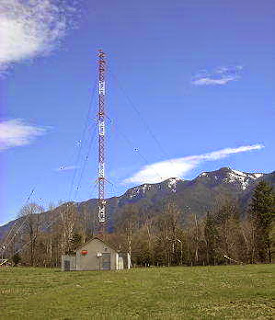 Hunting For NDB’s In CLE 206
Hunting For NDB’s In CLE 206
This coming weekend will see another CLE challenge, this time in the LF band from 190 - 239.9 kHz.
'CLE's' are 'Co-ordinated Listening Events', and NDB DXers around the world focus their listening time on one small slice of the NDB spectrum.
One nice catch to try for is 'LU' on 214 kHz shown on the left. The 'LU' NDB is in a breathtaking location, high on a mountain meadow at the foot of the North Cascade mountain range. In spite of the towering mountain peaks to the east and to the south, 'LU' is well heard, being reported as far east as Massachusetts and as far west as Hawaii.
The antenna is a 100' top-loaded vertical with, presumably, an extensive ground system as this is a very large site. The transmitter is a 500 watt Nautel. 'LU' is about 20 miles north-east of the Abbotsford Int'l Airport, Vancouver's alternate.
From CLE coordinator Brian Keyte (G3SIA), comes the following reminder:
Our 206th Co-ordinated Listening Event is next weekend.
Do join in if you can. First-time CLE logs will also be very welcome.
Days: Fri. 22 - Mon. 25 April, Midday-Midday, your local time
Frequencies: NDBs from 190 - 239.9 kHz
PLUS: Normal NDBs on 'half-way' frequencies nnn.5 kHz
(from 190.5 - 999.5 kHz)
Both halves are for everyone to try.
Away from Europe many of the frequencies below 240 kHz are busy with
NDBs. In Europe there are very few there, but some DX ones might be heard from North America and maybe from a few other places.
The normal NDBs (not DGPS) which have carriers on the 'half-way'
frequencies (e.g. 284.5 DY, 333.5 VOG, 370.5 LB, 390.5 ITR, 433.5 HEN)
are scattered across Europe but there are very few of them elsewhere.
'Hot spots' are ENG and ITA.
These half-frequencies give comfortable QRM-free listening and probably
some good catches as a result.
America has only one or two (e.g. 381.5 SJX) but East and West coasters
might hear some DX ones.
We last used these 'rules' for CLE190 in January 2015.
Please send your CLE log to the List in a plain text email if possible
(not in an attachment) with 'CLE206' at the start of its title.
Show on each log line:
# The date (e.g. 2016-04-22, etc., or just 22) and UTC.
(the date changes at 00:00 UTC)
# kHz (the nominal published frequency, if known)
# The Call Ident.
Show those main items FIRST - other optional details such as Location
and Distance go LATER in the same line.
If you send interim logs, please also send a 'Final' (complete) log.
As always, tell us your own location and brief details of the equipment
that you were using during the weekend.
Good listening - enjoy the CLE
----------------------------------------------------------
From: Brian Keyte G3SIA ndbcle'at'gmail.com
Location: Surrey, SE England (CLE co-ordinator)
----------------------------------------------------------
(If you wish you could use any one remote receiver for your loggings,
stating the location and owner - with their permission if required.
A remote listener may NOT also use another receiver, local or remote,
to make further loggings for the same CLE).
73
Brian
These listening events serve several purposes. They:
- determine, worldwide, which beacons are actually in service and on-the-air so the online database can be kept up-to-date
- determine, worldwide, which beacons are out-of-service or have gone silent since the last CLE covering this range
- will indicate the state of propagation conditions at the various participant locations
- will give you an indication of how well your LF/MF receiving system is working
- give participants a fun yet challenging activity to keep their listening skills honed
Final details can be found at the NDB List website, and worldwide results, for every participant, will be posted there a few days after the event. If you are a member of the ndblist Group, results will also be e-mailed and posted there.
The very active Yahoo ndblist Group is a great place to learn more about the 'Art of NDB DXing' or to meet other listeners in your region. There is a lot of good information available there and new members are always very welcome.
If you are contemplating getting started on 630m, listening for NDBs is an excellent way to test out your receive capabilities as there are several NDBs located near this part of the spectrum.
You need not be an ndblist member to participate in the CLEs and all reports, no matter how small, are of much value to the organizers. 'First-time' logs are always VERY welcome!
Reports may be sent to the ndblist or e-mailed to either myself or CLE co- ordinator, Brian Keyte (G3SIA), whose address appears above.
Please ... give the CLE a try ... then let us know what NDB's can be heard from your location! Your report can then be added to the worldwide database to help keep it up-to-date.














